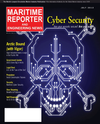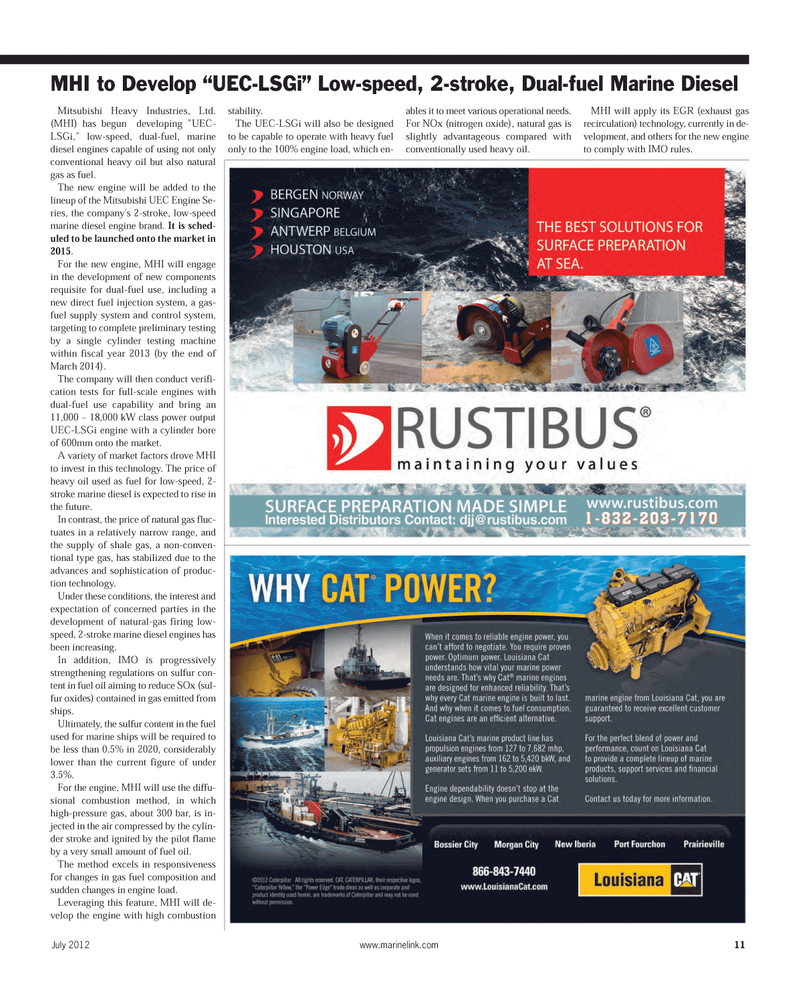
Page 11: of Maritime Reporter Magazine (July 2012)
Arctic Operations
Read this page in Pdf, Flash or Html5 edition of July 2012 Maritime Reporter Magazine
July 2012www.marinelink.com 11Mitsubishi Heavy Industries, Ltd. (MHI) has begun developing "UEC- LSGi," low-speed, dual-fuel, marine diesel engines capable of using not onlyconventional heavy oil but also natural gas as fuel. The new engine will be added to the lineup of the Mitsubishi UEC Engine Se-ries, the company's 2-stroke, low-speed marine diesel engine brand. It is sched-uled to be launched onto the market in 2015.For the new engine, MHI will engage in the development of new components requisite for dual-fuel use, including anew direct fuel injection system, a gas- fuel supply system and control system,targeting to complete preliminary testing by a single cylinder testing machine within fiscal year 2013 (by the end of March 2014). The company will then conduct verifi- cation tests for full-scale engines withdual-fuel use capability and bring an11,000 ? 18,000 kW class power output UEC-LSGi engine with a cylinder bore of 600mm onto the market. A variety of market factors drove MHI to invest in this technology. The price of heavy oil used as fuel for low-speed, 2- stroke marine diesel is expected to rise in the future. In contrast, the price of natural gas fluc- tuates in a relatively narrow range, and the supply of shale gas, a non-conven- tional type gas, has stabilized due to the advances and sophistication of produc- tion technology. Under these conditions, the interest andexpectation of concerned parties in the development of natural-gas firing low- speed, 2-stroke marine diesel engines has been increasing.In addition, IMO is progressively strengthening regulations on sulfur con- tent in fuel oil aiming to reduce SOx (sul-fur oxides) contained in gas emitted from ships. Ultimately, the sulfur content in the fuel used for marine ships will be required tobe less than 0.5% in 2020, considerablylower than the current figure of under 3.5%. For the engine, MHI will use the diffu- sional combustion method, in which high-pressure gas, about 300 bar, is in- jected in the air compressed by the cylin- der stroke and ignited by the pilot flame by a very small amount of fuel oil. The method excels in responsiveness for changes in gas fuel composition and sudden changes in engine load. Leveraging this feature, MHI will de- velop the engine with high combustion stability. The UEC-LSGi will also be designedto be capable to operate with heavy fuel only to the 100% engine load, which en-ables it to meet various operational needs. For NOx (nitrogen oxide), natural gas is slightly advantageous compared with conventionally used heavy oil. MHI will apply its EGR (exhaust gas recirculation) technology, currently in de- velopment, and others for the new engine to comply with IMO rules.MHI to Develop ?UEC-LSGi? Low-speed, 2-stroke, Dual-fuel Marine Diesel MR#7 (10-17):MR Template 7/9/2012 11:13 AM Page 11

 10
10

 12
12
